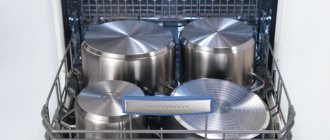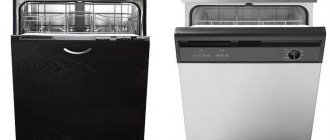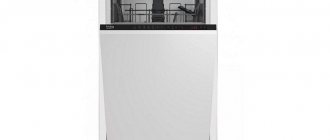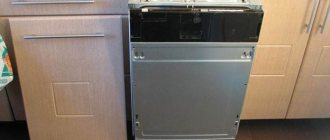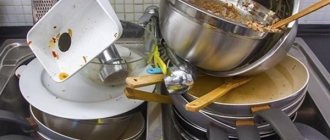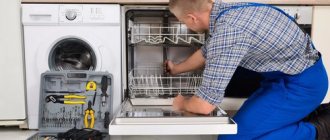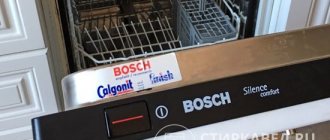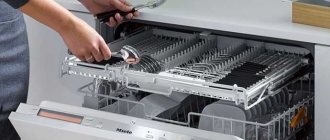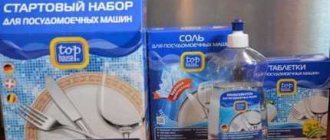In Western countries, the dishwasher has long become as integral a part of the home environment as the TV and refrigerator. In Russia, this technology is considered a luxury and an attribute of a rich life. Although, buying a dishwasher today is feasible for a family with an average income. And, judging by the reviews, even a non-professional can connect it to the mixer. Considering the size of most domestic kitchens, it is better to buy a tabletop dishwasher. But first, it’s still worth understanding the criteria for choosing this device.
Is a dishwasher a luxury or a necessity?
Our grandmothers washed dishes in bowls without changing the water, using rags and soda. Our mothers do this under running water, not sparing the delicate skin of their hands. Does this mean that our generation in the age of high technology should follow their example? Or is it still worth buying a dishwasher, saving yourself from this part of routine household chores? Using this technique has several undeniable advantages:
- a dishwasher washes dishes better than a human: it makes them glossy and leaves no streaks or smudges;
- the device thoroughly washes away the detergent, so it definitely won’t get into the body while eating;
- this saves the owner’s time and effort, and also protects her hands;
- When using a dishwasher, water consumption is less than when washing by hand; you can save up to 8,000 liters of water per year;
- after washing in the machine, the dishes are dry and can be immediately placed in the kitchen cabinet;
- Family disputes about whose turn it is to wash the dishes will disappear forever.
A tabletop dishwasher will be enough for a family of 2-4 people.
Although it is worth mentioning the disadvantages of using a dishwasher. Firstly, one cycle of its operation lasts 1-2 hours. Secondly, it consumes electricity. Thirdly, it takes up a lot of space in the kitchen, which in our country is already not very large.
Video
After watching the video, you can learn more about how to connect a dishwasher yourself:
Electronic engineer with many years of experience. For several years he was involved in organizing the repair of household appliances, including washing machines. Loves sport fishing, water tourism and travel.
Found a mistake? Select it and click the buttons:
History knows the fact that a kitten fell into the drum of a washing machine and, after going through a full wash cycle on the “Wool” program, got out of the unit unharmed. The only trouble for the pet was an allergy to washing powder.
The expression “soap opera” (“soap”) did not arise by chance. The very first series and shows that had a female audience were broadcast on television at a time when housewives did cleaning, ironing and laundry. In addition, to attract female viewers to the screens, commercials for detergents: soaps and powders were often played on air.
Washing machines have something to do with the origin of the expression “money laundering.” In the 1930s, American gangsters used a network of laundries as a cover for their illegal activities. By passing off the proceeds of crime as proceeds from cleaning clothes, they turned “dirty” money into “clean” money.
There are a variety of balls that are used in the washing machine. Antistatic ones will prevent the fabric from sticking to the body after washing, balls with special loops will “comb” the lint and prevent the appearance of pills, and silicone ones with pimples will prevent fluff from matting when washing outerwear.
The first officially patented washing machine was made of wood and was a box with a frame, half filled with wooden balls. Laundry for washing and detergent were loaded inside and the frame was moved using a lever, which, in turn, made the balls move and grind the laundry.
For washing small items on the road or in a hotel, it is convenient to use a regular plastic bag. Socks or tights are kneaded inside a tied bag along with water and a small amount of detergent. This method allows you to pre-soak things and wash them without damaging the fabric or wasting a lot of powder and water.
Washing machines equipped with the “No Iron” or “Easy Iron” functions can wash clothes with little to no wrinkling. This effect is achieved through a special approach to spinning - it is performed at low speeds, with long pauses, and a small amount of water is retained in the tank.
Astronauts, while in Earth orbit, solve the problem of dirty things using an original method. Clothes are dropped from the spacecraft and burn up in the upper atmosphere.
There is a washing machine “for bachelors”. Linen washed in such a unit does not need to be ironed at all! The thing is that the device does not have a drum: some things can be placed inside the container directly on hangers (for example, jackets and shirts), and smaller things (for example, underwear and socks) can be placed on special shelves.
Pros of a countertop dishwasher
One of the disadvantages of a dishwasher is its size. The built-in device looks very harmonious. But it needs to be purchased and installed at the stage of renovation and kitchen arrangement. The floor-standing machine can be installed at any time. But the question is, where to put it if most Russian kitchens are no more than 10 m²? Therefore, there is an optimal option - a tabletop dishwasher.
This car will fit organically into any interior. After all, on the modern market there are many models to suit every taste. In addition, such a device is cheaper than other modifications. If floor-standing and built-in machines cost 30-50 thousand rubles, high-quality floor-standing devices can be purchased for 15-20 thousand rubles.
Another undeniable advantage is savings. Due to its modest dimensions, such a dishwasher consumes less water, electricity and special detergent. It would seem that due to the small size of the device, a lot of dishes will not fit there. But judging by the reviews, for a family of 2-4 people this will be quite enough.
Useful tips
Now we will look at tips that will simplify the installation of desktop, built-in, in general, any PMM and make it more correct and reliable.
- Remember: installing a drain hose in a sink is considered an unsafe solution, despite the fact that the process itself is greatly simplified. There is always a chance that the outlet will simply fall out of the sink and you will flood your neighbors.
- Be sure to take into account that equipment from different brands has its own nuances in installation, especially when it comes to the angle of the hose. Therefore, be sure to study the technical data sheet of the device.
- If you buy and install the appliance after repairs have been made and a kitchen wall has been installed, carefully calculate the niche. It is important not to miscalculate the dimensions and standards regarding the placement of sockets and wiring requirements.
- You should never make a ground connection to gas or water pipes.
- There must be an air gap between the wall and the rear panel of the equipment of at least 5 cm.
- Always read the instructions that come with the equipment. After all, each brand has its own installation and connection nuances.
- Forget about extension cords as they are one of the most common causes of accidents and fires. Only a properly installed outlet can withstand the voltage.
- If it turns out that the PMM will be located near the stove, oven or refrigerator, then you need to connect a separate line from the outlet for each appliance.
If you are not an electrical specialist, then it is better to use the services of a specialist, since the level of safety for you and your loved ones depends on the correct placement of the outlet and compliance with all wiring requirements.
Connection Tips
First of all, you need to shut off the water supply to the apartment. After this, you need to insert a tee into the water supply in the kitchen, distributing water to the tap and dishwasher.
The machine drain can be connected directly to the sink siphon if the machine is located near the sink. The second option is to drain it into a sewer pipe. In any case, the drain should be 40 cm lower than the device itself. Otherwise, dirty water from the sewer may end up in the dishwasher. The device must be installed in such a way that the hose is not visible, and it should not be kinked.
Attention! Don't forget about the outlet near the dishwasher.
Preparation of tools and components
The washing units are connected using a copper stranded cable (2.5 mm) insulated . To fix the wire in the wall or in an open way, plastic channels are needed along the length of the installation.
Other necessary components for connecting to electricity :
- socket with moisture protection (water socket), protective cover, grounding terminal;
- external socket or internal with socket box;
- connecting blocks for wires;
- automatic machines and RCD devices or difavtomats;
- electrical tape, plaster for sealing the grooves.
To connect the dishwasher to the sewer and water supply you will need the following components :
- brass tee with shut-off valve or separate valve;
- siphon (hydraulic seal) with an outlet for washing and other equipment, for example, a washing machine;
- fum tape for insulating joints;
- clamps for fastening hoses;
- tee for draining waste water into the sewer;
- sewer collectors with a diameter of 50 mm;
- rubber gaskets;
- flow filter with removable consumables.
Tools include Phillips and straight screwdrivers, pliers, and a wrench. To create a pipe slope, use a laser or bubble level. You will need a drill, bits, a knife, a tape measure, and a pencil. Furrows in the wall for wiring are made with a grinder using a stone circle.
What not to put in the dishwasher
For a dishwasher to last a long time, it must be used correctly. The following must not be placed in the device:
- dishes stuck together;
- silver and aluminum dishes;
- dishes with wooden handles, wooden cutting boards;
- dishes made of non-heat-resistant plastic.
Attention! Even “allowed” dishes must be placed correctly, in accordance with the instructions. Otherwise, it will not wash properly.
It is difficult to find a person who would love to wash dishes. But dirty dishes in the sink are a depressing and unpleasant sight. Therefore, buying a dishwasher is the best solution for every family. Those who cannot decide to take this step should remember the famous advertising phrase that a wife and mother are a woman, not a dishwasher.
Other technical specifications
In addition to the type of installation (built-in), dimensions and capacity, each dishwasher has other technical characteristics:
- Weight, kg);
- maximum power consumption (kW);
- energy consumption class;
- washing class;
- drying class;
- energy consumption per cycle (kW/h);
- type of control;
- number of programs;
- number of temperature conditions;
- noise level (dB);
- water consumption;
- washing time with normal program (min.);
- connection type (cold or hot water);
- color of the control panel (or housing);
- warranty period, etc.
Which of these characteristics should you pay special attention to? Expert advice on this issue varies. Some talk about low energy consumption, others – about the number of temperature conditions, and still others – about the noise level. Let us examine the main of these criteria in more detail.
Energy class
Modern dishwashers are divided according to energy efficiency into seven energy consumption classes: A+++, A++, A+, A, B, C, and D. The most economical machines belong to the A+++ class, and those with the highest energy consumption belong to the class D.
But the fact is that almost all dishwashers presented on our market have a class of at least A. That is, no matter what model you choose, it will be energy efficient. Of course, other things being equal, it is better to choose a machine with a higher class - A+ or even A++. But there are not many such models.
Only some models from a few manufacturers, such as Gorenje or Delonghi, can boast the highest class (A+++). Class A++ can be found in Electrolux, Delonghi or Maunfeld dishwashers. And such a well-known brand as Bosch produces mainly class A dishwashers.
The washing class and drying class of most dishwashers coincide with the energy consumption class (class A) or are one or two positions lower than it. You don't have to rely on these two indicators.
Noise level (dB)
This is a more important indicator. In many homes, dishwashers run at night because the night electricity rate is cheaper than the daytime rate. Dishwasher noise levels range from 37 to 60 dB, with the majority ranging from 43 to 55 dB. Figures up to 45 dB are considered excellent indicators; these are the quietest machines. The lower the noise level of household appliances, the better.
Maximum power consumption (kW)
Power consumption depends on many circumstances. A more powerful household appliance heats water and dries dishes faster. What matters is the equipment of the device, the type of drying, whether it is possible to connect to hot water, etc. Devices with higher power are more expensive.
Control type
There are two types of control: electronic and electromechanical. Electromechanics are practically not produced anymore; this is a thing of the past. All modern household appliances are electronically controlled.
Number of programs and number of temperature modes
The more a dishwasher is equipped with all sorts of functions, the more expensive it is. But experience shows that housewives often use only one program, for example, automatic (45-65 °C) or Eco (50 °C).
Advice. To wash regular dishes, it is enough to have 1-2 programs. For example, few people use the “Intensive 70 °C” program for washing pots. Experience shows that it takes too long and does not wash dried and burnt food well enough. It is easier and faster to wash the pan by hand.
Connection type - cold or hot water
Most dishwashers only connect to cold water. But there are models with the ability to connect to hot water, which save energy and time. Experts recommend choosing dishwashers that run on cold water.
The quality of hot water supply in many homes is far from ideal. The temperature is unstable, the filters become clogged quickly. The recommended temperature of supplied hot water for PMM is strictly from 40 to 60 °C. These parameters in our homes are not always stable. Conclusion: you shouldn't overpay for this feature.
Attention! From the instructions.

